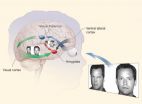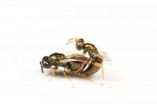(Press-News.org) Standing and walking for longer stretches improves insulin sensitivity and blood lipid levels more than an hour of intense exercise each day does, but only if the calories spent in both forms of exercise are similar. The findings are published February 13 in the open access journal PLOS ONE by Hans Savelberg and colleagues from Maastricht University, Netherlands.
The researchers recruited eighteen normal-weight 19 to 24-year-old participants for their study and asked them to follow three regimes. In the first, participants were instructed to sit for 14 hours each day and not indulge in any form of exercise; the second regime required participants to sit for 13 hours each day and exercise vigorously for 1 hour; and in the third, participants substituted six hours of sitting with four of walking and two hours standing. After each regime, the researchers tracked each participant's insulin sensitivity and blood lipid levels, both of which can help identify metabolic conditions like diabetes and obesity.
The authors found that overall, when participants followed the strictly sedentary regimen they burned over the course of the day than in the other two routines, which were roughly the same. Cholesterol and lipid levels improved slightly when participants exercised vigorously for an hour each day, but improved significantly when participants were active for longer periods at low intensity According to the study, being active simply by standing or walking for long periods of time significantly improved insulin levels compared to both a strictly sedentary lifestyle, and one in which participants were largely sedentary except for an hour of exercise each day. The study concludes that when energy expenditure is equivalent, longer durations of low-intensity exercise may offer more benefits than shorter periods of intense activity.
###
Citation: Duvivier BMFM, Schaper NC, Bremers MA, van Crombrugge G, Menheere PPCA, et al. (2013) Minimal Intensity Physical Activity (Standing and Walking) of Longer Duration Improves Insulin Action and Plasma Lipids More than Shorter Periods of Moderate to Vigorous Exercise (Cycling) in Sedentary Subjects When Energy Expenditure Is Comparable. PLoS ONE 8(2): e55542. doi:10.1371/journal.pone.0055542
Financial Disclosure: The authors have no support or funding to report.
Competing Interest Statement: The authors have declared that no competing interests exist.
PLEASE LINK TO THE SCIENTIFIC ARTICLE IN ONLINE VERSIONS OF YOUR REPORT (URL goes live after the embargo ends): http://dx.plos.org/10.1371/journal.pone.0055542
Long, low intensity exercise may have more health benefits relative to short, intense workouts
If spending equal amounts of energy, long periods of low intensity exercise may improve insulin, lipid levels more than short bursts of intense activity
2013-02-14
ELSE PRESS RELEASES FROM THIS DATE:
New owl species discovered in Indonesia is unique to one island
2013-02-14
A new owl is the first endemic bird species discovered on the island of Lombok, Indonesia, according to research published February 13 in the open access journal PLOS ONE by an international team headed by George Sangster of the Swedish Museum of Natural History and colleagues from other institutions.
The new species has long been confused with a more widespread Indonesian owl species because of its similar plumage. However, in September 2003, two members of the team independently discovered that the vocalizations of the owls on Lombok were unique and different from ...
The party in your brain
2013-02-14
A team of political scientists and neuroscientists has shown that liberals and conservatives use different parts of the brain when they make risky decisions, and these regions can be used to predict which political party a person prefers. The new study suggests that while genetics or parental influence may play a significant role, being a Republican or Democrat changes how the brain functions.
Dr. Darren Schreiber, a researcher in neuropolitics at the University of Exeter, has been working in collaboration with colleagues at the University of California, San Diego on ...
Threat bias interacts with combat, gene to boost PTSD risk
2013-02-14
Soldiers preoccupied with threat at the time of enlistment or with avoiding it just before deployment were more likely to develop post-traumatic stress disorder (PTSD), in a study of Israeli infantrymen. Such pre-deployment threat vigilance and avoidance, interacting with combat experience and an emotion-related gene, accounted for more than a third of PTSD symptoms that emerged later, say National Institutes of Health scientists, who conducted the study in collaboration with American and Israeli colleagues.
"Since biased attention predicted future risk for PTSD, computerized ...
CU-Boulder amphibian study shows how biodiversity can protect against disease
2013-02-14
The richer the assortment of amphibian species living in a pond, the more protection that community of frogs, toads and salamanders has against a parasitic infection that can cause severe deformities, including the growth of extra legs, according to a new study by the University of Colorado Boulder.
The findings, published Feb. 14 in the journal Nature, support the idea that greater biodiversity in larger-scale ecosystems, such as forests or grasslands, may also provide greater protection against diseases, including those that attack humans. For example, a larger number ...
Sustainable new catalysts fueled by a single proton
2013-02-14
CHESTNUT HILL, MA (Feb. 14, 2013) – Chemists at Boston College have designed a new class of catalysts triggered by the charge of a single proton, the team reports in the most recent edition of the journal Nature. The simple organic molecules offer a sustainable and highly efficient platform for chemical reactions that produce sets of molecules crucial to advances in medicine and the life sciences.
Unearthing a reliable, truly general, efficient synthesis of single mirror-image isomers has proven elusive. Previous methods suffer from a combination of extreme temperatures, ...
'Significant' proportion of HIV positive patients may not be telling NHS staff about their infection
2013-02-14
A significant proportion of HIV positive patients may not be disclosing their infection to NHS staff, when turning up for treatment at sexual health clinics, suggests preliminary research published online in the journal Sexually Transmitted Infections.
If the findings reflect a national trend, this could have implications for the true prevalence of undiagnosed HIV infection in the population, which is based on the numbers of "undiagnosed" patients at sexual health clinics, say the authors.
Currently, it is estimated that around one in four people in the UK who is HIV ...
California's Tobacco Control Program generates huge health care savings, UCSF study shows
2013-02-14
Over a span of nearly 20 years, California's tobacco control program cost $2.4 billion and reduced health care costs by $134 billion, according to a new study by UC San Francisco.
Additionally, the study -- covering the beginning of the program in 1989 to 2008 -- found that the state program helped lead to some 6.8 billion fewer packs of cigarettes being sold that would have been worth $28.5 billion in sales to cigarette companies.
The study was designed to calculate the fiscal impact of California's large public health program on smoking prevalence and cigarette consumption. ...
Cracking the semantic code
2013-02-14
We make choices about pretty much everything, all the time – "Should I go for a walk or grab a coffee?"; "Shall I look at who just came in or continue to watch TV?" – and to do so we need something common as a basis to make the choice.
Dr John Fennell and Dr Roland Baddeley of Bristol's School of Experimental Psychology followed a hunch that the common quantity, often referred to simply as reward, was a representation of what could be gained, together with how risky and uncertain it is. They proposed that these dimensions would be a unique feature of all objects and ...
Finding 'Mr. Right,' how insects sniff out the perfect mate
2013-02-14
TEMPE, Ariz. – You may want to ramp up your romance this year by sharing a candlelight dinner, a walk on the beach, or even the scent of a perfume, but will that help you find your perfect mate? For one wasp species, it only takes a whiff of his special love potion to know whether he's "Mr. Right."
Unlike humans, most insects rely on their sense of smell when looking for a mate. Scientists have found that sex pheromones play an important role in finding a suitable partner of the same species; yet, little is known about the evolution and genetic basis of these alluring ...
Scientists discover how animals taste, and avoid, high salt concentrations
2013-02-14
New York, NY (February 13, 2013) —For consumers of the typical Western diet—laden with levels of salt detrimental to long-term health—it may be hard to believe that there is such a thing as an innate aversion to very high concentrations of salt.
But Charles Zuker, PhD, and colleagues at Columbia University Medical Center have discovered how the tongue detects high concentrations of salt (think seawater levels, not potato chips), the first step in a salt-avoiding behavior common to most mammals.
The findings could serve as a springboard for the development of taste ...
LAST 30 PRESS RELEASES:
New prostate cancer trial seeks to reduce toxicity without sacrificing efficacy
Geometry shapes life
A CRISPR screen reveals many previously unrecognized genes required for brain development and a new neurodevelopmental disorder
Hot flush treatment has anti-breast cancer activity, study finds
Securing AI systems against growing cybersecurity threats
Longest observation of an active solar region
Why nail-biting, procrastination and other self-sabotaging behaviors are rooted in survival instincts
Regional variations in mechanical properties of porcine leptomeninges
Artificial empathy in therapy and healthcare: advancements in interpersonal interaction technologies
Why some brains switch gears more efficiently than others
UVA’s Jundong Li wins ICDM’S 2025 Tao Li Award for data mining, machine learning
UVA’s low-power, high-performance computer power player Mircea Stan earns National Academy of Inventors fellowship
Not playing by the rules: USU researcher explores filamentous algae dynamics in rivers
Do our body clocks influence our risk of dementia?
Anthropologists offer new evidence of bipedalism in long-debated fossil discovery
Safer receipt paper from wood
Dosage-sensitive genes suggest no whole-genome duplications in ancestral angiosperm
First ancient human herpesvirus genomes document their deep history with humans
Why Some Bacteria Survive Antibiotics and How to Stop Them - New study reveals that bacteria can survive antibiotic treatment through two fundamentally different “shutdown modes”
UCLA study links scar healing to dangerous placenta condition
CHANGE-seq-BE finds off-target changes in the genome from base editors
The Journal of Nuclear Medicine Ahead-of-Print Tip Sheet: January 2, 2026
Delayed or absent first dose of measles, mumps, and rubella vaccination
Trends in US preterm birth rates by household income and race and ethnicity
Study identifies potential biomarker linked to progression and brain inflammation in multiple sclerosis
Many mothers in Norway do not show up for postnatal check-ups
Researchers want to find out why quick clay is so unstable
Superradiant spins show teamwork at the quantum scale
Cleveland Clinic Research links tumor bacteria to immunotherapy resistance in head and neck cancer
First Editorial of 2026: Resisting AI slop
[Press-News.org] Long, low intensity exercise may have more health benefits relative to short, intense workoutsIf spending equal amounts of energy, long periods of low intensity exercise may improve insulin, lipid levels more than short bursts of intense activity


